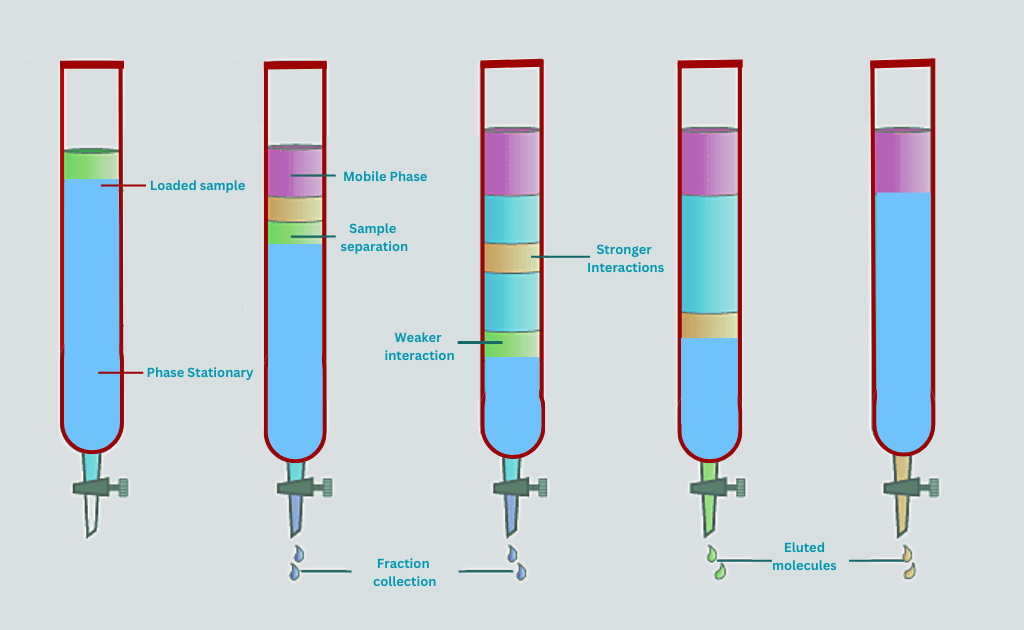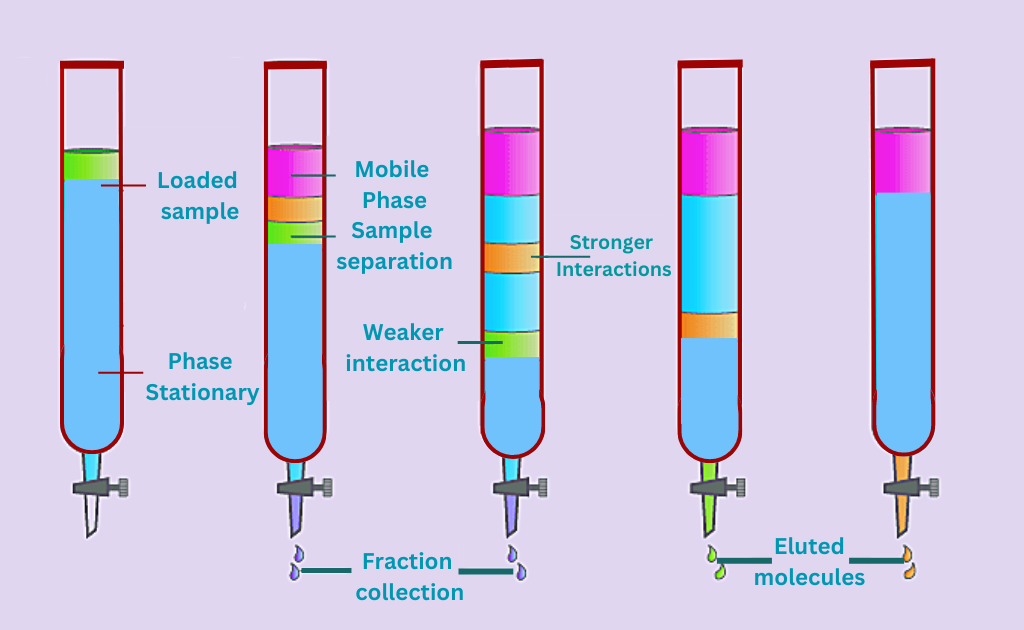Written By Adeel Abbas
Column chromatography is a widely used technique of chromatography in chemistry to separate and purify a mixture of chemical compounds. Mostly it is used in natural product isolation.
I also used this technique during my research on Boerhavia Procumbens. The goal of this technique is to isolate each component in a mixture based on its physical and chemical properties. In this article, we will take a closer look at what column chromatography is, its principle, procedure, and applications.
What is Column Chromatography?
Table of Contents
Column chromatography is a separation technique in which a column is used. The column is filled with a solid stationary phase which is silica. it is tightly packed for better separation. A liquid mobile phase to separate a mixture of chemical compounds is passed through the column. The mobile phase dissolves compounds and flows out of the column.
Column Chromatography Principle
The principle of column chromatography is based on the fact that different components in a mixture have different affinities for the stationary and mobile phases. When the mixture is passed through the column, the components will separate based on their different interactions with the stationary and mobile phases. This allows each component to be isolated and collected separately.
Common mobile and stationary phase used in column chromatography
| Mobile Phase | Stationary Phase |
| Hexane | Silica gel |
| Ethanol | Sephadex LH-20 |
| Acetonitrile | C18 |
| Methanol | Florisil |
| Water | Reverse-phase silica |
| Toluene | Alumina |
| Chloroform | Diol |
| Acetone | Ion exchange resins |
| Isopropanol | Cellulose |
| Petroleum ether | Polymeric resins |
Column Chromatography Diagram
A column chromatography setup typically consists of a column, a pump, a detector, and a collection system, and holding clamps. A detector is used in advance columns. At basic level it is done manually by performing thing layer chromatography and checking it under uv lamp.
The column is filled with the stationary phase and the mixture is introduced at the top of the column. The mobile phase is then pumped through the column, carrying the mixture along with it. As the mixture passes through the column, the components will separate based on their different interactions with the stationary and mobile phases. The separated components are then collected at the bottom of the column.

Column Chromatography Procedure
The procedure for column chromatography can vary depending on the type of column and the specific requirements of the separation. However, the basic steps of a column chromatography procedure are as follows:
- Prepare the stationary phase and fill the column with it.
- Load the mixture to be separated at the top of the column.
- Start the flow of the mobile phase through the column.
- Monitor the progress of the separation with a detector.
- Collect the separated components at the bottom of the column.
- Perform elution to wash the components from the column.
Column Chromatography Experiment
Column chromatography experiments are a key part of many chemistry research projects and are used to separate and purify different components in a mixture. The following is a step-by-step guide to performing a column chromatography experiment:

1: Choose the appropriate column chromatography technique
There are several different techniques of column chromatography to choose from, including ion exchange chromatography, gel filtration chromatography, reverse phase chromatography, affinity chromatography, and hydrophobic interaction chromatography. The choice of technique will depend on the properties of the mixture and the desired outcome of the separation.
2: Prepare the stationary phase
The stationary phase is the material in the column that will retain the components of the mixture. It is important to choose the appropriate stationary phase for the separation and to prepare it according to the manufacturer’s instructions.
3: Load the mixture
The mixture to be separated should be carefully loaded into the column. It is important to take care not to damage the stationary phase or to introduce any contaminants into the column.
4: Start the flow of the mobile phase
The mobile phase is the liquid that will flow through the column and carry the mixture along with it. It is important to choose the appropriate mobile phase for the separation and to set the flow rate correctly.
5: Monitor the progress of the separation
The progress of the separation can be monitored using a detector, such as a UV-Vis spectrophotometer. The detector measures the amount of each component in the mixture as it passes through the column.
6: Collect the separated components
The separated components will be collected at the bottom of the column. It is important to collect the components in a way that preserves their purity and to store them correctly for further analysis.
7: Perform elution
Elution is the process of washing the separated components from the column. This is done by changing the conditions of the mobile phase, such as the solvent or the flow rate, to release the retained components from the stationary phase. The eluted components are then collected for further analysis or use.
In conclusion, a column chromatography experiment is a carefully controlled process that requires careful attention to detail in order to obtain accurate and reproducible results. By following the steps outlined above, you can perform a successful column chromatography experiment and obtain high-quality separated components for your research.
Types of Column Chromatography
There are several types of column chromatography, each with its own unique characteristics and applications. Some of the most commonly used types of column chromatography include:
- Ion Exchange Column Chromatography
- Gel Filtration Chromatography
- Reverse Phase Chromatography
- Affinity Chromatography
- Hydrophobic Interaction Chromatography
Column Chromatography Applications
Column chromatography is a powerful tool for separating and purifying different components in a mixture. The following are some of the most common applications of column chromatography:
- Biotechnology: Column chromatography is used extensively in the biotechnology industry to purify proteins and other biological molecules for use in research and as therapeutic drugs.
- Pharmaceuticals: Column chromatography is used in the pharmaceutical industry to purify active ingredients and impurities from drug products. This is important for ensuring the quality and safety of drugs.
- Environmental analysis: Column chromatography is used in environmental analysis to separate and identify contaminants in water, air, and soil samples.
- Food and beverage analysis: Column chromatography is used in the food and beverage industry to analyze food ingredients, such as vitamins and minerals, and to monitor the quality of food and beverage products.
- Analytical chemistry: Column chromatography is a common technique in analytical chemistry for separating and purifying different components in a sample for further analysis. This can be used in fields such as drug discovery, forensic science, and metabolic profiling.
- Process chromatography: Column chromatography is also used in process chromatography to purify large quantities of a product, such as a food ingredient or a pharmaceutical, for commercial use.